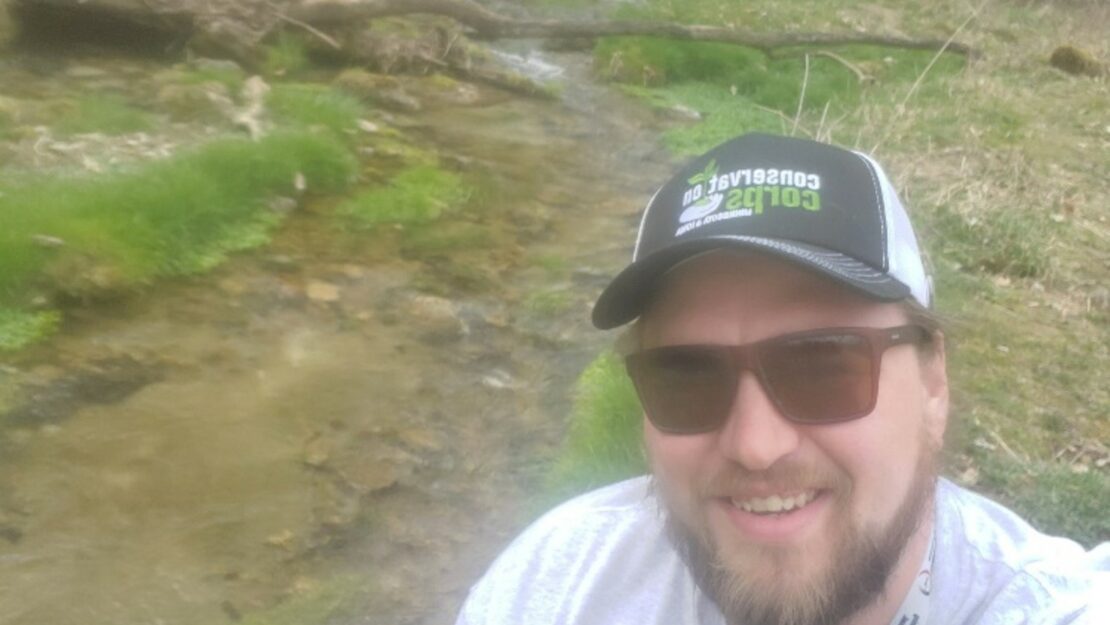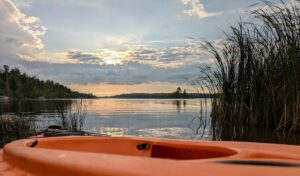Individual Placement Spotlight Series: Sam Fryer

By Jesse Wolk, Utility Mapping Specialist Individual Placement / AmeriCorps Member placed at Minnesota Department of Natural Resources, Division of Parks and Trails
XI: The Carrotier
The Individual Placement (I.P.) Spotlight Blog is a series of interviews between Jesse Wolk and his fellow full-term I.P. members. The goal of the series is to highlight their unique positions, projects, and backgrounds while simultaneously reflecting on their service term in the context of the Natural Resources career field in Minnesota. In the eleventh edition of the series, The Carrotier, the spotlight is shifted to our Agricultural Outreach Specialist – Sam Fryer!
In my last post, The Carrot, I described in technical detail how Soil and Water Conservation Districts (SWCDs) attempt to mitigate the environmental impact of agriculture by incentivizing farmers to become more sustainable. Adriene was the focus of that edition. Her background to the position was atypical, from an urban area with little ties to agriculture or conservation, but her passion was there. In most AmeriCorps positions, especially the I.P. program, this is the norm. Little experience but so much interest that they are willing to serve a community in need with little financial benefit. Through his institutional knowledge, Sam Fryer, the other I.P.’s Agricultural Outreach Specialist, sews a slightly different seam on that narrative.

a farm that he assessed.
Sam grew up on the western edge of bluff country in Chatfield Minnesota. Sam has fond memories of his hometown. “It was a great place to grow up,” Sam honestly remarked. Especially for budding outdoor enthusiasts. Proudly, he reminisced to me about a summer when he was fourteen, “My friends and I made a challenge to go fishing every day. We did it.” Additionally, Sam was immersed in the agricultural community. Sam’s father, an Agricultural Engineer with an SWCD, knew many famers in the area and Sam stated that as a result, he “did plenty of work for farmers” as a kid. He grew up surrounded by, and a part of, farming culture.
In college, Sam headed up north to Duluth and found himself in a relatable position to quite a few young people. He found himself getting a degree in something he didn’t enjoy. Unlike many others, Sam took the brave step of quitting school to give himself time to think. He earned that time by working a communications position and some restaurant jobs for a few years. Eventually, he figured out that environmental science would be his best fit and started his attempt at to returning to school. Frustratingly, the classes that Sam needed that fall weren’t available until the spring. Sam figured he’d wait one more semester, and then get back on track. Unfortunately for Sam, the spring he planned to start was the spring of 2020. This disrupted many of Sam’s plans and he stayed with his marketing position until the summer of 2023 where he was again displaced, this time by Artificial Intelligence. His other part-time job also ran dry. Sam quickly found himself back in Chatfield with his parents. As he noted, he felt like he had, “failed miserably.”
At this point, Sam was looking for basically any position but still had his eyes set on conservation. As you can probably tell, this is where Sam’s luck changed. He found out about the Conservation Corps of Minnesota and Iowa and applied for a field crew. During the interview, someone mentioned the Agricultural Outreach position based out of Rochester, near Chatfield, which Sam realized was a perfect fit for his background.
Today, Sam serves under the direction of eleven (!) Soil and Water Conservation Districts but mainly in Olmsted County. Much like Adriene, one of Sam’s main tasks is to have conversations with interested farmers on how an SWCD can help them transition to environmentally friendly practices. Unlike Adriene, Sam’s familiar understanding of agricultural jargon, culture, and practices has allowed him to lead conversations with farmers. With some training, Sam also conducts environmental assessments based on the answers to his questions. Using ArcGIS Pro, Sam determines their impact on the landscape by aggregating their tillage depth, fertilizer and pesticide use, and their current conservation practices. If farmers get a high enough grade and clear Sam’s assessment, then they get a Minnesota Agricultural Water Quality certification, receive a contract with an SWCD, and clear any state regulations for the entirety of their contract regardless of changes. For the duration of the contract, they also receive 5,000 dollars annually for conservation projects, from stand improvement to cover-crops to grazing rotation, with a 75% cost share from a governing agency. If they don’t make the cut, then Sam helps them to incorporate practices that will get them the score they need to qualify for the certification. When Sam isn’t working with new farmers interested in the program, he verifies that existing contracts are being honored by farmers currently partnered with an SWCD.

After my research a couple weeks ago on the impact of intensive agriculture on our landscape, I was interested to hear about Sam’s experience. Sure, he was told off by an angry farmer who didn’t want the government meddling in his affairs. Ironically, this same farmer was receiving a 5,000 subsidy through the SWCD program. However, Sam has also said that he’s had plenty of conversations with people where he expected a similar response but didn’t get one. For Sam, angry responses have not been the norm. From my perspective, this is because Sam is skilled at what he does. Using a scientific, financial, and emotional but passive argument, Sam can demonstrate to farmers that their current practices are damaging, costly, and unsustainable without offending them. Sam taps into his technical and culture knowledge to get farmers to trust his advice without being pedantic or rude. Referring to him and his partners’ overall strategy, Sam summed it up like this, “We’re not there to tell (farmers) how to farm, we’re there to tell (farmers) that their grandkids may not be able to drink their water.” Essentially, Sam shows them the dark road that they are headed down and gives them options to switch lanes but leaves it to them to turn the wheel.
When I asked Sam how well this strategy was working, he said it was going well. Sam said through one conversation, he was able to show that a farmer could save 50,000 dollars a year just by decreasing fertilizer use to University of Minnesota recommended levels. As effective as these conversations are, he also notes that SWCDs are overworked and understaffed. Not enough of these conservation conversations (say that five times fast) are happening. Furthermore, current conservation projects have a multi-year wait period for technical assistance. On the bright side, this does show that the demand is high and could indicate that agriculture is becoming more sustainable. On the darker side, it demonstrates that an important need is not being met.

Back to Sam’s experience, he reported to me that he has loved getting out in the field and talking to people that are passionate about the environment. For the most part, Sam gets to help people that want to make a change, and this has kept him motivated. When Sam isn’t conducting site visits, he has been able to use his training budget to attend quite a few SWCD training events and conferences, and a Boundary Waters symposium held by the Aldo Leopold Center. Following this service term, Sam hopes to start a certifier position with the Minnesota Department of Agriculture where he hopes to finally have stability in a position that he enjoys.
Overall, Sam’s story gives me hope. With conservation’s immediate future not looking the brightest, it is nice to hear that people like Sam are encouraging a radical change in their respective field at basically a cornroots level. Sam is doing his best to demonstrate to farmers that grabbing the carrot is in not just in our future society’s best interest but their own right now.
Hopefully, it’s enough.
Jesse Wolk (he/him) is currently a Utility Mapping Specialist in the Individual Placement Program who is serving for the Minnesota Department of Natural Resources’ Division of Parks and Trails.